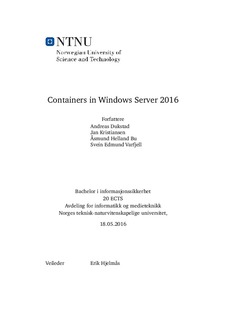| dc.contributor.advisor | Hjelmås, Erik | |
| dc.contributor.author | Dukstad, Andreas | |
| dc.contributor.author | Kristiansen, Jan | |
| dc.contributor.author | Bu, Åsmund Helland | |
| dc.contributor.author | Varfjell, Svein Edmund | |
| dc.date.accessioned | 2016-08-25T09:43:37Z | |
| dc.date.available | 2016-08-25T09:43:37Z | |
| dc.date.issued | 2016-08-25 | |
| dc.identifier.uri | http://hdl.handle.net/11250/2401617 | |
| dc.description.abstract | Denne bacheloroppgaven ble utformet for å besvare Ikomms spørsmål angående implementasjon av Windows Container i Windows Server 2016. Gruppen har i denne oppgaven utforsket funksjonaliteten til containere i Windows Server 2016 - technical preview 4 og arkitekturen bak, og deretter målt ressursutnyttelse opp mot eksisterende virtualiseringsteknologier. Gruppen sitter i etterkant igjen med et inntrykk av at Windows Container ikke er en moden teknologi. Mangelen på et grafisk grensesnitt og RDP-støtte innsnevrer bruksområdene til containere betraktelig. Microsoft har gitt utrykk for at dette heller ikke vil bli støttet i endelig utgave av Windows Server 2016. Windows er i stor grad et grafisk operativsystem, og de fleste programmer har grafiske komponenter som de er avhengig av, noe som forsterker denne problematikken. Under vår testing kommer Windows Container ytelsesmessig ut både svakere og mer ustabil satt opp mot virtuelle maskiner kjørt i Hyper-V, men stort sett med små marginer. Ettersom målet med containere er å få en bedre utnyttelse av eksisterende hardware, tyder dette på at Windows Container ikke er godt nok optimalisert. Med denne begrunnelsen sammen med et manglende behov for horisontal skalering fra Ikomms side, anbefales de ikke å implementere Windows Container i sin serverpark. | nb_NO |
| dc.description.abstract | This bachelor thesis was designed to answer a series of questions from Ikomm regarding the implementation of Windows Container in Windows Server 2016. This thesis explores the functionality of containers in Windows Server 2016 - technical preview 4, the architecture behind, and compared resource utilization benchmarks to existing virtualization technologies. After finishing the thesis the group is left with the impression that Windows Container is not yet a mature technology. The lack of a graphical interface and RDP support narrows the usecases for containers considerably. Microsoft has expressed that this will not be a functionality in the final release of Windows Server 2016 either. Windows is largely a graphical operating system, and most programs have graphical components that they depend on, which reinforces this issue. During our testing, the performance of Windows Container has been shown to be both weaker and more unstable when compared to virtual machines running in Hyper-V, albeit not by much. However, since the objective of containers is to achieve a better utilization of existing hardware, it suggests that Windows Container is not sufficiently optimized. With this rationale along with Ikomm not being limited by horizontal scaling, we advice them not to implement Windows Container in their server park. | nb_NO |
| dc.language.iso | nob | nb_NO |
| dc.subject | Docker | nb_NO |
| dc.subject | Windows Server 2016 | nb_NO |
| dc.subject | Containere | nb_NO |
| dc.subject | containerteknologi | nb_NO |
| dc.subject | ytelsestesting | nb_NO |
| dc.subject | Containers | nb_NO |
| dc.subject | containertechnology | nb_NO |
| dc.subject | benchmarking | nb_NO |
| dc.title | Containers in Windows Server 2016 | nb_NO |
| dc.title.alternative | Containere i Windows server 2016 | nb_NO |
| dc.type | Bachelor thesis | nb_NO |
| dc.subject.nsi | VDP::Mathematics and natural science: 400::Information and communication science: 420::Security and vulnerability: 424 | nb_NO |
| dc.source.pagenumber | 177 | nb_NO |
